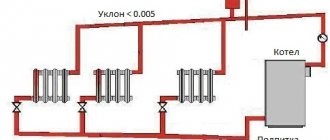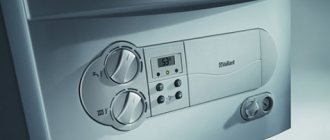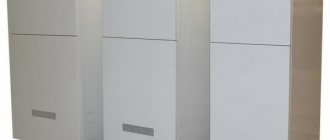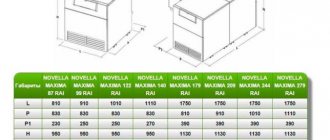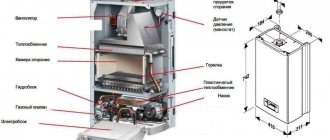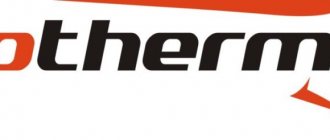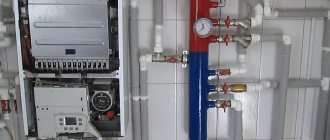The Proterm brand has long been known on the Russian market: gas equipment regularly performs its functions for heating and hot water supply in both residential buildings and small industrial facilities. Sometimes equipment breaks down. If the reason is a manufacturing defect, then it is better to replace the boiler immediately, but minor problems can usually be eliminated on their own.
We will tell you how you can repair a Proterm gas boiler yourself, based on self-diagnosis data and the manufacturer’s recommendations. We'll show you how to identify a malfunction of equipment using the code. We will advise you on how to accurately determine the cause of the breakdown by decoding.
In the article we present you will find a description of the popular positions in the model range of boilers of this brand. Get acquainted with typical malfunctions in the operation of units for heating systems and methods for troubleshooting.
Basic errors and malfunctions in Protherm gas boilers
All possible problems are constantly monitored by self-diagnosis system sensors.
This is a group of thermistors and other elements that are triggered when the specified operating mode changes. The signal from the sensor passes to the electronic control board, which immediately gives an alert on the display. An alphanumeric code appears, such as F 01 or F 28.
Each combination indicates a particular error, i.e. failure or failure of the corresponding unit unit.
IMPORTANT! A complete list of errors, quite long, is outlined in the instructions, which are recommended to be kept on hand to quickly identify the problem node.
The operation of a gas boiler is entirely based on the use of a burner. This is the main and most critical component of the device, since it is the burner that performs the main task and is the source of maximum danger.
This determines the degree of control over its operation by the boiler automation. In addition, the condition of the heating circuit (presence and pressure of water) and the smoke removal system are subject to increased attention.
The Protherm boiler self-monitoring system includes several dozen items in its list, most of which determine the condition of gas equipment and smoke exhaust systems as areas of increased danger. However, less important elements are not left unattended.
Prevention recommendations
Maintenance by service center
Every year, preferably before the first turn on after the summer break, it is recommended to invite a specialist from a certified service organization to inspect and test the boiler. During a preventive inspection, the condition of the gas burner is checked, the power is adjusted, and the burner nozzles and heat exchangers are cleaned. A particularly important part of the inspection is checking the operation of the emergency thermostat and the combustion chamber thermostat.
Boiler user maintenance
Cleaning the unit lining without removing the protective casing. Must be carried out after disconnecting the device from the network. Power supply is allowed only after complete drying.
The water pressure in the heating circuit must be checked weekly. If necessary, top up after the unit has cooled below 400°C.
It is necessary to regularly, at least once every three months, check the tightness of the connections of the chimney system, the cleanliness of the filter and mud pan, and remove dirt if necessary.
If a gas leak is detected, the device must be immediately turned off, the gas valve closed and a service specialist must be called. It is not recommended to repair the unit yourself. For example, the instruction manual for the Cheetah wall-mounted double-circuit gas boiler manufactured by Proterm does not recommend trying to fix faults yourself, so as not to lose the company’s warranty.
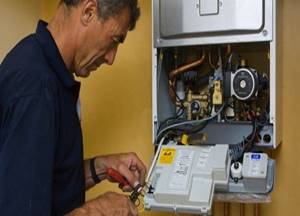
F0
The error informs about a critical drop in pressure in the system (below 0.65 bar), leading to an emergency stop of Protherm. Make-up clears the fault code. But this measure is a temporary solution to the problem. The heating circuit is a closed system, and the error cannot be caused by evaporation of the coolant.
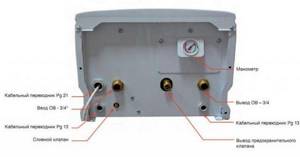
Top up your heating system with water

Protherm make-up tap
Advice
If the heating system requires replenishment regularly, the leak is caused by a minor defect. Finding a microcrack is difficult due to the evaporation of coolant from hot materials (plastic, metal). If water treatment is organized correctly, then no traces of rust, yellow stains, or characteristic deposits remain on the damaged area. Solution: Wait until surfaces cool. The drops will begin to flow down, and it is not difficult to determine the defective area of the circuit.

Water leak near the heating expansion tank
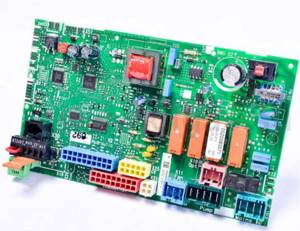
Protherm boiler control board
Variety of gas equipment Proterm
This manufacturer offers consumers gas equipment of the following modifications:
- Boilers "Gepard". In these wall-mounted units, the coolant moves forcibly.
- Double-circuit devices "Tiger". They are also placed on the wall, but they are equipped with an electronic control system.
- Heating devices “Grizzly” and “Bear” have automatic control of the combustion process and a special ignition system.
- The Lynx and Leopard boilers are equipped with bithermal heat exchangers. They are also double-circuit.
- Wall-mounted “Panther” devices are capable of functioning in closed heating systems.
Repair of domestic gas boilers: what you need to know about the design of the unit
Any part of the boiler can fail for any reason: poor-quality assembly components, improper operation, an object hit the expansion tank (and now there are puddles under it every day). Be that as it may, the repair of protherm gas boilers or any other must be carried out very carefully, especially if it concerns the safety team responsible for proper operation.
At the moment, any master responsible for repairing Baxi or other gas boilers knows that the safety group consists of the following elements:
- draft sensor with a plate rated at 75 degrees Celsius. This device monitors the condition of the boiler chimney, reacts to failures in the removal of combustion products into the chimney, and their exit into smoke eliminators. As a result, it heats up and goes off, but it is best if, in addition to it, a gas alarm is purchased;
- monostat to protect turbo boilers from insufficient smoke removal due to a clogged heat exchanger or chimney;
- limit thermostat that controls the water in the boiler. If it boils, the overheating sensor turns off the boiler;
- ionization electrode to monitor the presence of flame. Quite often, the repair of Viessmann gas boilers begins with checking the electrode, since operating a gas boiler without a flame can even cause an explosion.
- blast valve for pressure control. At a pressure above 3 bar, the system will force the boiler to release dangerous excess.
Distinctive features
We have already mentioned most of these features in passing in the previous paragraphs, but, in addition to them, it is also worth saying that:
- The company's boilers are an extremely good solution in terms of price/quality ratio. Of course, they are not cheaper than Chinese crafts, but in comparison with the nearest branded goods, they have simply record figures. At the same time, you get a decent device with a guarantee of up to 5 years, during which it will already have time to recoup the money spent. And thanks to the reliable materials in the boiler, it will last for several decades if scheduled inspections are carried out in a timely manner.
- The previously mentioned turbo attachment, which can be additionally connected to the boiler, will allow for the forced removal of combustion products, even through ventilation, which is not suitable for this according to GOST.
And now you have decided to buy a boiler, all that remains is to think about how to install it in an apartment or private house.
Causes of failure
The smoke exhauster may be faulty for the following reasons:
- The inductor is damaged. Under the influence of high temperatures resulting from the removal of hot gases or motor overload, the insulation of the wire melts, which leads to an interturn short circuit or a break in the coil winding.
- The turbine is unbalanced. During the process of removing smoke, the fan blades become covered with soot, dust, etc., which leads to a change in the center of gravity of the wheel.
- Bearings are worn out. The armature shaft is equipped with plain or rotation bearings. If the turbine is unbalanced or there is insufficient lubrication, the service life of these components is reduced.
- There is no power to the smoke exhauster. The impeller will not rotate if the control board module responsible for supplying power to the fan is faulty.
- Low mains voltage. When the electrical voltage supplied to the boiler is less than 195 volts, the pressure switch can turn off the fan, since due to the reduction in power, sufficient vacuum is not created. An underestimated gas boiler supply voltage does not lead to fan failure but creates the effect of a malfunction.
Service life of a wall-mounted boiler
This type of heating boiler is most in demand due to its low price and small size, but many buyers of such equipment do not know that they work much less than floor-standing options.
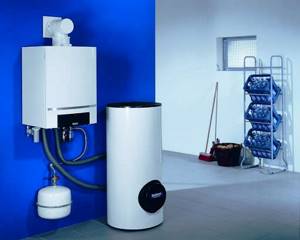
This is due to various factors:
- Almost all wall-mounted units are equipped with copper heat exchangers, in contrast to cast iron in floor-standing units. Copper makes the heating structure light, but it wears out quickly and requires a high level of purification of the circulating water. If this is not done, the copper will oxidize and the internal heating surfaces will become clogged with scale. From practice it follows that a copper boiler heat exchanger, even with good operation, can work for no more than 5-8 years, at a level of 12-18 for the cast iron version.
- A chimney with natural circulation cannot develop the power of the flame, so there is a temperature imbalance in the combustion chamber, leading to accelerated decommissioning of the unit.
- Wall-mounted boiler units generally have the lowest power and therefore operate with overload, which also significantly reduces the service life of a gas boiler in a private home.
How to change a thermocouple?
Only a specialist should replace the device, as this is very dangerous. If the fastening is not airtight, then any breakdown of the device will give a spark, which will cause the gas stove to explode. To avoid a fire in your home, do not replace the thermocouple yourself, but ask a specialist to do it.
To replace the device, you will need to buy a new thermocouple from a specialized store. When choosing this device, choose only a high-quality device that will serve you for many years. Before buying a new device, consult with a specialist who will recommend exactly the sensor that is suitable for your gas stove or water heater.
Replacing a thermocouple sensor on a gas boiler is a little more complicated. In a gas boiler, a thermocouple made of chromium and aluminum or chromel and copel is most often used; an iron constant is less often used. All of these metals are designed to withstand high temperatures, and such sensors are often used in the foundry industry.
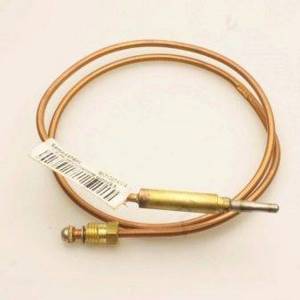
The gas boiler control system consists of an electromagnetic valve and a thermocouple.
To replace a device, you need to follow a series of sequential steps.
- Using a wrench, unscrew the nuts that secure the thermocouple to the solenoid valve, then you need to remove one of the ends of the thermocouple.
- Inspect the connectors. If they contain various contaminants or oxidation, they must be cleaned. For this you will need fine-grained sandpaper.
- Check the thermocouple sensor using a multimeter. To do this, attach one of the metal ends of the device to the multimeter, and heat the other with a lighter or torch. The multimeter reading should be within 50 mV.
- After that, if the indicator matches the data, you need to collect it in the same sequence. If not, then most likely it will have to be replaced.
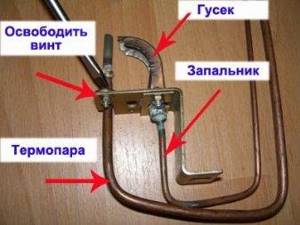
Replacing the thermocouple in the oven of a kitchen gas stove is carried out differently. First you need to remove the lid of the gas stove; it is located on the opposite side from where the oven tap handle is located.
Remove the cap, but first clean it with sandpaper. If the terminal is removed, the cap rotates freely. When you see the center valve, check it. If it is faulty, it needs to be replaced. Remove the terminal by pulling it downwards with your fingers. Remove the cap and turn off the valve on the gas riser; now you can connect the burner and check the operation of the device.
After this, use a wrench to unscrew the nut and carry out diagnostics. Check the valve and thermocouple separately.

Why exactly Proterm boilers?
Proterm is a Czech brand that has gained a positive reputation in the domestic market of heating devices. The Protherm company produces modern gas heating boilers with excellent operational and technical performance. In terms of quality and characteristics, the products are not inferior to Asian and European analogues. Therefore, Proterm boilers are widely in demand among consumers.
The Proterm heating boiler is unique in that each device is assembled by one worker. The principle of personal responsibility comes into play here. The company produces floor and wall heating equipment, cascade boiler modules, and boilers. Having studied the reviews of Protherm gas boilers, we can safely say that the equipment is very popular and has gained trust among users. Buyers note the high quality, ease of maintenance, reliability and durability of units produced by Proterm. Boiler heating at home is an ideal option for the private sector.
The excellent quality and reliability of Proterm boilers is achieved thanks to:
- the presence of 7 production lines: one line for the production of high-power boiler appliances, three for the production of floor-standing types of units and three more lines for the production of wall-mounted gas boilers;
- output control of boiler devices is carried out on each production line;
- More than 200 types of components from European manufacturers are used in production;
- planning and management of the production process is carried out using the SAP information system;
- equipment is subject to annual testing in foreign laboratories. Also, the quality management system is checked every year by the organization “Bureau Veritas Quality International”;
- before putting the boiler into production, it is subject to rigorous testing for reliability and durability;
- safety elements and control units are carefully checked for each gas boiler;
- Every day, about 2% of manufactured products are subject to detailed testing;
- The technological base is constantly being modernized and improved.
Despite the European quality, the price for the Proterm gas boiler is quite affordable. The product range is quite wide and is represented by different models.
Related Posts
- Setting up gas boiler power adjustment
- Turbocharged or atmospheric gas boiler? which one should I take?
- Types and principle of operation of a gas boiler for heating a private house
- Ariston double-circuit gas heating boilers
- The operating principle of a double-circuit gas boiler. classification and advantages
- How to correctly calculate the power of a gas boiler
- Combined heating boilers with wood and gas
- Description of the floor-standing boiler Proterm Bear
- Review of Siberia gas boilers
- How to choose a wood-electricity combi boiler
- Review of Rinnai gas heating boilers
- Wall-mounted, non-volatile gas boilers
- Review of electric boilers proterm
- Replacing a gas boiler in a private house: documents, rules and procedures
- Why does a gas boiler go out: what could be the reasons and what to do if it turns off
- Review of the electrolux basic gas boiler
- Review of baxi double-circuit gas boilers
- Thermal relay with remote temperature sensor: operating principle
- Characteristics and principle of operation of an induction heating boiler
- Do-it-yourself gas boiler installation: design and instructions for use (125 photos)
- The best electric boiler for heating a home according to customer reviews
- How to reduce the power of a gas boiler: the best options to reduce gas consumption by the boiler
- Uninterruptible power supplies for heating boilers of any type
- Connecting and calculating a buffer tank to a solid fuel boiler
- Electrode boiler for heating a private house
Read with this
- Setting up gas boiler power adjustment
- Turbocharged or atmospheric gas boiler? which one should I take?
- Types and principle of operation of a gas boiler for heating a private house
- Ariston double-circuit gas heating boilers
- The operating principle of a double-circuit gas boiler. classification and advantages
- How to correctly calculate the power of a gas boiler
- Combined heating boilers with wood and gas
- Description of the floor-standing boiler Proterm Bear
- Review of Siberia gas boilers
- How to choose a wood-electricity combi boiler
Construction of electric boilers
The design of the electric heating boiler includes:
- Heating unit (heating element, electrodes, induction coil). The heating element or electrodes are always located in the middle of the tank. The induction coil can be in and around it. In the first case, it is always located in a sealed housing.
- Circulation pump.
- Thermal switch. It protects the boiler from overheating. Always connected to the temperature sensor located at the top of the electric boiler.
- Automatic air valve. It is located above the heating tank. In case of excess pressure, releases air from the container.
- Safety valve. Connected to the return pipe. It releases water into the sewer if the pressure exceeds the established standards.
- Pressure gauge.
- The node that controls power. Usually it is a coil that changes the voltage depending on the specified settings.
- Control Panel.
- Expansion tank.
Other faults
Error 00
Temperature sensor malfunction (shutdown).
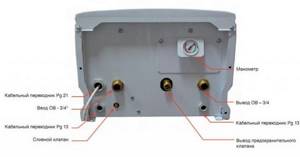
Connection terminals for the Proterm Skat boiler
What to do:
Error a6
It occurs due to low air temperature in the room where the boiler is installed, simply put, in the boiler room. To eliminate it, increase the temperature by installing a radiator in the boiler room.
Error f04
Indicates problems with ionization. Restart the device and see if the gas valve is closed.
Error f05
Indicates that there is not enough air for the boiler to operate. Check if the chimney channel is clogged, if there is sufficient draft, open a window in the room where the boiler is installed.
Reasons why the boiler does not turn on
If the heating equipment does not light up at all, the reasons include the following factors:
- the ignition system has failed;
- the gas supply is stopped or the tap on the pipe supplying it is closed;
- too low or high gas pressure inside the pipe;
- The burner nozzle is clogged.
If it doesn't light up the first time
Failures of a gas heating unit, in which case they light up immediately, are caused by various factors. External:
- too low gas pressure level in the main pipeline;
- problem with the functioning of the chimney;
- voltage fluctuations;
- draft or low temperature inside the building where the boiler is located.
Internal ones include failure of electronics, pump, heat exchanger.
If the unit goes out and then does not immediately light up, the cause of this phenomenon may be a lack of ventilation in the room. This often happens with heating devices “Proterm”, “Navien”, etc., in which the combustion chamber is open. They take combustion air from the room.
Other faults
When the pressure in the line drops, the dual-circuit devices “AOGV” or “Vailant”, for example, are switched off. This also happens when the fuel supply fluctuates. If the igniter is incorrectly adjusted, the protection is triggered and the boiler stops working.
To determine other faults, knowledge of the device that requires repair is required. Each model has its own distinctive features. But more often than not, components, sensors or circulation pumps break down for all brands. If such a pump fails, the burner will not turn on and the boiler will not be able to supply hot water and heating. It happens that the pump hums, but there is no work. It's quite possible it's jammed.
Sometimes the whole house can hear how loud and hard the boiler is working. This is most often caused by a large amount of scale in the heat exchanger. This factor often leads to overheating of the heat exchanger.
Injectors can also make a whistling sound. This happens when the boiler is ignited. A whistle indicates the presence of air in the gas pipeline. To eliminate the whistling, it is enough to release the air.
If water or condensation gets on the main board, irreparable damage occurs inside it. If the cause is moisture, streaks are visible on the board.
Attention! For long service life of gas equipment, the board must be protected from water leaks and steam ingress
Error codes, their causes and solutions
The interpretation of error codes for Proterm units is approximately the same for different models. If you want to find out in detail what malfunctions of the Protherm Leopard or Panther gas boiler indicate, take a look at their operating instructions. Below are all possible error codes.
codes F00 and F01 – flow and return temperature sensors are turned off. This error means that ignition is blocked and fuel supply through the gas valve is stopped. It can be caused not only by a direct malfunction, but also occur due to the activation of the safety system - the emergency thermostat. Low fuel inlet pressure, incorrect phase and zero connections can also cause loss of flame.
What to do if the gas boiler blows out?
Gas boiler does not reach temperature - causes and methods of eliminating them
Details about why a gas boiler works non-stop
F10, F11 – short circuit of flow and return sensors.
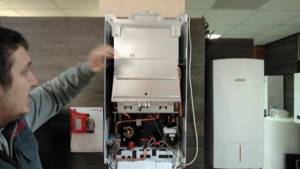
Code F13 – boiler sensor is broken. Check the wiring of the sensors and their functionality.
…
Error F20 indicates an overheating problem. This happens due to a lack of heating water flow in the system. To fix the problem you need to:
- check the operation of the pump and, if necessary, unblock it;
- inspect the thermal filter;
- make sure that the shut-off valves are open;
- check the DHW circuit.
Code F22 – lack of water in the system. The reasons are usually:
- leak in the heating system - add coolant;
- expansion tank defect - check the tank.
F23 – the maximum difference between the supply and return temperatures has been reached. This usually occurs when there is a problem with water circulation. Check the supply and return sensors, pay attention to the operating mode of the pump.

Error F24 means problems with water circulation. Appears as a result of weak pump operation or low water pressure. The pump operating mode may need to be adjusted, or there may be a coolant leak in the system.
F25 (for models with a classic chimney) – the system has detected an excess of smoke in the draft exhaust channel. Check the exhaust pipe - it may be clogged and needs cleaning. Check to see if the ventilation is working well. Check the smoke detector.
…
Code F26 - no voltage through the stepper motor valve . This code occurs due to a malfunction of this element. Check the operation of the stepper motor and its connector.
F27 - error in receiving a flame signal, although the gas valves are closed. The logic of the process is broken. Check the following items:
- flame sensor;
- Protherm boiler main board;
- gas fittings for tightness.
F28 – no flame during ignition. The reasons for the appearance of the code are as follows:
- Incorrect gas valve settings - check and readjust;
- the valve is broken - replace the part;
- ignition sensors are faulty - check their condition;
- there is no grounding.
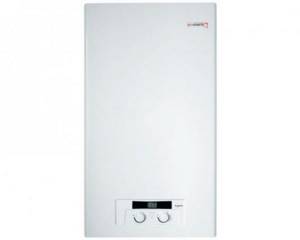
Error code F29 means loss of flame during combustion . The reasons may be as follows:
- lack or absence of fuel - check the gas supply unit;
- carbon deposits on the ionization sensor - check the sensor;
- problems with the ignition and fire control system.
F33 – problem with differential relay. The switch does not turn to the off position. (OFF) if the fan is turned off. Check the differential relay. There may be a blockage in the smoke exhaust duct or the wind has changed direction.
Error F42 – coding resistor failure. Check its functionality.
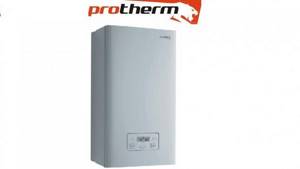
Code F61 - malfunction of the main circuit board . The cause is a malfunction in the gas valve control. Restart the unit. If this doesn't help, check:
- all connections to the circuit board;
- operability of the electronic board.
F62 – failure to close the gas valve.
F63 – problem with the main board memory.
F64 - circuit main board error . Appears due to rapid changes in the parameters of the supply and return heat sensors.
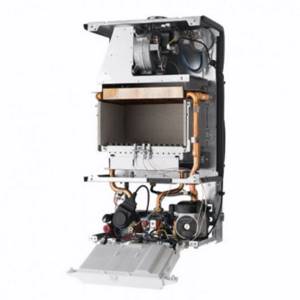
F65 – electronic board error. The temperature of the main control board is too high.
F67 - error on the main board of the unit . Fire signal failure.
F68 – fire signal fluctuations.
Error code F70 appears when the user interface is not compatible with the electronic board.
F72, F84 – temperature difference between flow and return sensors . Check the wiring of the flow and return temperature sensors, replace the broken sensor if necessary. F73 – failure of the heating circuit pressure sensor. Tighten the sensor wiring or replace the broken element. Code F74 – electrical malfunction of the pressure sensor.

F77 – failure of external equipment. Check the connections of the condensate pump and external gas valve.
F83 - means there is no liquid in the system - the temperature does not increase when the burner is running. Most likely, there is excess air in the heat exchanger. Code F85 is a problem with the flow and return sensors - they are connected to the same pipe. Check the functionality of the temperature sensors.
DIY boiler repair
Many users with experience in operating domestic gas boilers are accustomed to repairing them themselves, but in the case of Western-made analogues filled with modern electronics, this cannot be done.
Firstly, the warranty will be violated, and secondly, this may lead to breakdown of other important components. A boiler is an object with increased danger, and a gas unit is doubly dangerous, so you should not experiment with your own safety and the safety of loved ones. Therefore, experts advise repairing Protherm boilers only by specialized organizations.
What can you repair yourself?
Nevertheless, the owner can carry out some of the repair work on Protherm heating boilers independently, without compromising the warranty and performance of the boiler. Such work includes types of preventive operations and cleaning of unit elements, without disassembling the main components.
List of repair work that you can perform on your own on the Proterm boiler:
- If error F0 indicates low coolant pressure in the circuit, you need to disconnect it from the fuel and check the water supply line and the operation of the circulation pump; perhaps the error will be eliminated after deflating the air lock and replenishing the line to 1-2 atm.
- F3/F20, signals a high temperature of the coolant, check the filter in front of the device on the circulation line, it may be clogged with sludge or the fittings are faulty and the shut-off valve will need to be re-installed.
- F23, low temperature difference between forward and return, check the contacts of the primary sensors, they may be oxidized and need to be cleaned.
- F25, danger of gas contamination in the room due to low vacuum in the firebox, check for blockages along the flow of flue gases and the air supply to the firebox.
- F27/F28/F29, errors related to the burner device and the presence of a torch in the furnace, the communication line between the sensor and the shut-off valve may be broken, and the ignition electrodes may be damaged by corrosion. An external inspection is performed and contacts and electrodes are cleaned.
Decoding
To eliminate the fault code f04 of the Proterm boiler, you do not need to call a service representative - the operation of the heating unit is restored independently. The difficulty is that it is interpreted differently if you study the correspondence on thematic forums. Hence the differences in recommendations for elimination. This is a consequence of the variety of models of Protherm gas boilers and the similarity in error designations. For some units it is indicated as F4 (reason - NTC DHW), in the instructions for others (Proterm Jaguar) - f04.
p, blockquote 2,0,0,0,0 —>
This error informs that the electronic unit does not receive a signal from the ionization sensor about the presence of a burner flame. Appears on the display during unit operation or at startup. The reasons causing error f04 on different Protherm boilers are identical. To save time when troubleshooting the problem, the following troubleshooting algorithm is recommended.
p, blockquote 3,0,1,0,0 —>
What to do
Step 1
Perform a reset. Errors in gas heating equipment are initiated by problems with the supply voltage: a decrease in value, a jump, a temporary shutdown. Fault codes can be cleared by pressing the “NETWORK” or RESET buttons (depending on the model).
p, blockquote 4,0,0,0,0 —>
Step 2
Make a switch: pull out the plug from the socket, turn it over, and put it back in place. The functioning of a number of Proterm boilers depends on the correct connection to the network. The electronic circuit is phase-dependent, reacts if 0 and zero are applied to the board contacts F and zero
220 respectively. Error f04 will disappear.
p, blockquote 5,0,0,0,0 —>
Step 3
Advice
The lack of gas supply to the Proterm boiler is also caused by malfunctions of the devices included in the main line: a meter, a reducer, a filter or an ice plug, or the depletion of LPG volume in the tank (with an autonomous supply). It is easy to check whether “blue fuel” is supplied to the house by checking the gas stove. The pressure is judged by the uniformity of the flame of all burners, intensity, and height of the reeds. Any of the factors causes the Proterm boiler to stop with error f04. Decision: depending on the circumstances.
p, blockquote 6,1,0,0,0 —>
Step 4
Inspect the ionization sensor.
There are several reasons why error f04 appears:
Step 5
Clean the burner. Gradually, the injectors become clogged with dust and soot falling from the heat exchanger body. The mixture does not pass through the holes, the flame disappears, and error f04 is displayed. Solution: remove dirt with a brush and vacuum cleaner. You should not use pneumatics (for blowing), as some websites recommend - microparticles will scatter throughout the interior of the Proterm and the room.
p, blockquote 7,0,0,0,0 —>
Step 6
Assess the condition of the electronic board. Diagnostics are carried out in a service workshop on a stand that simulates the operation of a Proterm boiler in various modes. You can independently determine only visible defects: damage to tracks, melting of parts, chips (cracks) of housings, charred areas. Error f04 appears when the ionization sensor-board circuit is broken: evaluate the reliability of the contacts.
p, blockquote 8,0,0,0,0 —>
Step 7
Check the operation of the gas valve.
p, blockquote 9,0,0,1,0 —>
The unit is controlled by commands from the electronic board of the Proterm boiler and is responsible for supplying “blue fuel” to the burner and its dosing. Incorrect operation, block failure causes error f04. Self-disassembly is not practical. The main problem is the deposits of microparticles in the cavity of the copper tube connected to the inlet of the fittings. Solution: disconnect, clean off sludge, join. Be sure to change the O-ring and check for gas leaks.
p, blockquote 10,0,0,0,0 —>
In practice, the recommendations given make it possible to remove error f04 from the Proterm boiler. If the result is negative, contact the service department, indicating the model and year of manufacture of the heating unit.
p, blockquote 11,0,0,0,0 —>
Share your experience
If you have experience in correcting error F 04 in a Protherm gas boiler, write in the comments to this article, we will try to consider your option and analyze it in detail in this or one of the following articles. You can also send photos and videos with comments and descriptions.

Czech-made Proterm gas boilers have long established themselves as reliable and easy-to-use heating devices. There are many different modifications of these units on the market: floor-mounted - bear, wall-mounted - cheetah, lynx, panther. All of them are equipped with a liquid crystal display, so all faults of the Proterm gas boiler appear on it.
Review of the Proterm brand series
If we consider gas-fired equipment, then according to the installation location, all boilers can be divided into two large categories:
- wall mounted – “Lynx Condence” and “Lynx”, “Panther”, “Jaguar”, “Cheetah”;
- floor-standing – “Bear” (series KLOM, KLZ17, PLO, TLO), “Bison NL”, “Grizzly KLO”, “Wolf (Volk)”.
Despite the Turkish and Belarusian assembly, the quality of the equipment is high in European style.
Among the wall-mounted models are 1- and 2-circuit, atmospheric and turbocharged, with a power of 11-35 kW.
Floor-standing models are made of steel or cast iron, equipped with injection or fan burners, and can operate on natural and liquefied gas. The power range is wide – 12-150 kW – so choosing a device for specific conditions is easy.
The main purpose of the equipment is to organize hot water supply and heating in private residential buildings, and some units are designed for industrial use
Each series has distinctive features regarding design, dimensions, installation method, technical characteristics, additional functions:
- “Lynx” - condensing models are 12-14% more economical than non-condensing models, therefore they are recognized as energy-efficient devices for heating country houses and cottages.
- "Panther" - the latest models are available with a convenient eBus communication bus and an updated security system
- “Jaguar” - the main advantages are the low price of the unit and the possibility of separately adjusting two circuits - heating and hot water.
- “Cheetah” is a popular wall-mounted model that can be installed outside the city, in a country house or cottage, or in a city apartment.
- “Bear” - among the representatives of various series - are reliable units with a built-in boiler, a cast-iron heat exchanger and a power of up to 49 kW.
- “Bison NL” are universal models in terms of the fuel used: they operate equally efficiently on gas, fuel oil or diesel fuel, power up to 71 kW.
- "Grizzly KLO" - capable of heating private houses and office premises with an area of up to 1500 m², maximum power - 150 kW.
- “Wolf” is an electrically independent boiler with a steel heat exchanger that stably supplies heat to country houses and residential buildings even in the absence of electricity.
According to consumer reviews, Proterm units are reliable, efficient, easy to install and operate, and with regular maintenance they hardly fail.
However, durable materials, good fuel and excellent assembly do not guarantee impeccable service, so boilers of all the listed series sooner or later require replacement of spare parts, cleaning or repair.
The main advantages of Proterm boilers
As you know, you can heat a house not only with gas, but also with diesel, etc. And if at the moment you need a diesel boiler, but in the future you plan to switch to gas, then it is not necessary to buy two heating devices, because Protherm gas boilers are sold today.

Of course, each model has a different power, but they still compare favorably with other boilers in this parameter. The fact is that they can be used to heat rooms with a total area of 270 square meters. In addition, all products of this brand are easy to use and install, and this is an ideal option for those who value safety first. And it’s not surprising, because all boilers of this brand fully comply with European and world standards.
Note! It is worth adding that all Proterm heating devices have another amazing characteristic - unusual fuel combustion. Even experienced experts are surprised how environmentally friendly this process is in this case.
Low-temperature cast iron is used in the manufacturing process. And this, who doesn’t know, is a material that extremely effectively minimizes heat loss during heating. Another feature of boilers can be called special mechanisms, thanks to which the owners, even independently, without anyone’s help, will be able to create the most favorable microclimate in their home. And with the help of a special temperature sensor - a kind of magic wand - you can change the heating power. In a word, all the advantages of the products described are very significant, so the choice, frankly speaking, is quite obvious.
Errors in Proterm floor units
If there is a problem with the Proterm Bear floor-standing gas boiler, error codes appear:
- F2 – temperature sensor malfunction. This error indicates a breakdown of the temperature sensor or a decrease in the coolant temperature to 3ºC. The operation of the unit is blocked, since switching on at a temperature below 3ºC is not allowed by the manufacturer.
- F3 signals an increase in coolant temperature to 95ºC. In this case, the unit is blocked. It will resume operation after the liquid has cooled.
- F4 – boiler sensor failure. In this case, the unit does not heat the liquid in the boiler.
- F5 – external temperature sensor is broken. The unit remains operational, but the coolant temperature will be regulated by the boiler sensor.
You can try to reset the error code that appears on the screen for the first time by pressing the “RESET” key. If this does not help and you cannot determine the cause of the failure, call a specialist from the Proterm service center.
Conclusions and useful video on the topic
Recommendations for repairing the Proterm Gepard boiler:
Potential problems of the Panther boiler and their solution:
Cleaning and diagnostics of the “Bear” boiler:
Two categories of people engage in independent repairs: home craftsmen who enjoy it, and equipment owners who are trying to save on calling a specialist. If you do not belong to these groups, we recommend that in the event of a serious breakdown, contact the service center immediately.
What is an electric boiler
An electric boiler is a special high-tech equipment designed for heating various types of premises. A distinctive feature of such a unit is the use of a special type of fuel - electrical energy. In many respects, the boiler is superior to equipment operating on other types of fuel: liquid, solid, gas.
Electrical equipment is considered the safest to use. But in order for it to function well, it is necessary to strictly follow the rules of its operation and perform timely technological maintenance.
Watch the video about the operating principle and design of the Protherm Skat electric boiler.
Device
Despite the wide variety of boilers with different operating principles, the design of all models is approximately the same. The main place in the structure is given to the heating element. Depending on the type of heater used and the principle of its operation, there are several types of boiler units.
All heating elements are located in heat exchangers, which are considered the main structural elements of the boiler unit. If they malfunction, heating of the coolant is impossible.
Depending on the design and manufacturer, the equipment may have different configurations.
- Electronic control unit. Regulates the temperature by turning the equipment on and off at the right time.
- Circulation pump (heat pump). It is a mandatory component of the system and maintains a stable speed of coolant movement in the circuit. It produces forced circulation of liquid and creates the necessary pressure in the system, while ensuring the most effective heat exchange and heating of the room.
- Expansion tank. Not all types of electric boilers with a pump are equipped with an expansion tank. Therefore, if you purchase equipment without a tank, you will need to purchase this part separately and install it by cutting it into the pipe heating circuit.
- Filters. They purify and remove various impurities from water.
- Safety valves. Protect the system from unwanted deviations in operation.
- Safety valve. Connected to the return pipe. Performs emergency water release when the pressure rises above the established norm.
- Pressure gauge. This device determines the pressure of liquids and gases inside the boiler and pipes of heating systems; it is necessary for monitoring.
- Thermal switch. Shuts down equipment when it overheats. Connected to a temperature sensor located at the top of the electric boiler.
- Automatic air valve. It is located above the heating tank and produces an emergency release of air from the tank in case of excess pressure.
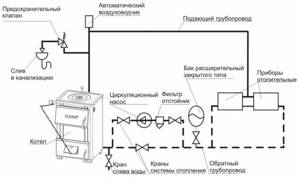
Electric heating elements
The principle of operation is based on simple electrical heating of elements that give off their heat to the liquid. Heating element – heating element. Water or other approved liquids are used as a coolant, in accordance with the operating instructions.

Induction
Their action is based on the principle of electromagnetic induction. The heating element is a coil, inside of which there is a pipeline filled with water. When an electric current passes through the coil under the influence of an electromagnetic field, the coolant heats up.
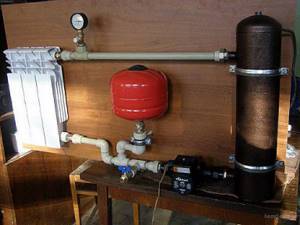
Ionic
The working element in such structures are electrodes placed in a special aqueous medium, where the process of heating the coolant occurs when alternating current passes through it.
A feature of the use of this type of boiler is the mandatory monitoring of the electrical conductivity of the liquid and the adoption of measures to regulate it. The phenomenon of electrolysis and breakdown should not be allowed. Failure to comply with these requirements may result in equipment failure.
The liquid used cannot be used for domestic purposes. The heat carrier, which circulates through the pipes and enters the working tank of the boiler, comes into direct contact with the electric current. It is not recommended to carry out repair and commissioning work without the involvement of an experienced technician.
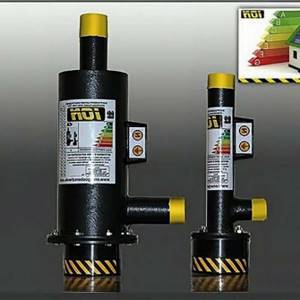
Specifications
The Gepard model range is presented in the retail network with installations of 2 varieties: 23 MTV and 11 MTV. There are two modifications of Gepard units: atmospheric, equipped with an open type firebox with natural smoke exhaust and closed with forced removal of combustion products using a blower fan.
Technical characteristics of Gepard 23 MTV:
- The type of fuel used is natural/liquefied gas.
- Thermal performance - 23.3 kW.
- The maximum pressure in the boiler circuit is 3 atm.
- The operating efficiency of the device is 93.2%.
- The maximum hot water output of a high-speed DHW boiler is 11 l/min.
- The heating range of the coolant in the heating system is from 35 -75 C.
- The heating range of the coolant in the DHW system is from 35 -55 C.
- The maximum hourly gas volume is 2.64 m3/h.
- Weight - 34 kg.
Is it worth taking on the repairs yourself?
In a typical gas boiler, all structural elements are conventionally combined into three groups:
- burner;
- blocks that are responsible for safety;
- a heat exchange unit equipped with a fan, circulation pump, and many other elements.
During repairs, the main safety risk arises from possible gas leaks. The reason for this may be improper repair, dismantling or installation of equipment with fuel supply functions.
Because of this, it is better to have these structural parts repaired by a specialist. In addition, it is not allowed to independently troubleshoot faults in the electronic equipment of a gas boiler. The automatic system is quite specific, and unless you have the appropriate qualifications, it is impossible to correctly restore this type of equipment in practice.
And yet, if you do not have enough experience, it is better to entrust the maintenance of heating boilers and the repair of geysers to professionals.
What can you repair yourself?
All other elements can be repaired yourself, for example:
- The heat exchanger is washed manually (to do this, the unit is dismantled, after which it must be correctly put back in place). You can perform this work without dismantling - using pumps.
- Chimney cleaning will be needed in cases where there is a problem with draft (mechanical or chemical removal of blockages is carried out).
- Repair of the boost fan by lubricating its bearings with technical oil.
In fact, you can repair a gas boiler yourself only in cases where there are mechanical damages or blockages that can be easily identified visually (or by smell).
Other breakdowns are considered more serious, so they are repaired with the help of a specialist, and not with your own hands.
Localizing the problem of boiler malfunction
With the development of modern low-rise construction and gas networks, the boiler has become a common household appliance in every house or apartment. Basically, after installation, the boiler does not cause users any trouble. Modern boilers operate completely autonomously and require only regular maintenance or inspection. In our opinion, the average operating time of units before the first breakdown is from 4 to 6 years. Some users encounter problems even after 9 years, and some, on the contrary, earlier. In this material I will tell you what can be done if the boiler simply does not turn on, and I will also consider the most common malfunctions of gas boilers. The concept of “does not turn on” can mean completely different problems:
- There is no indication (the display is not lit)
- The boiler does not light up
- The boiler does not operate in any particular mode
Therefore, these different situations should be considered separately in detail. Please note that to eliminate some malfunctions, user intervention is sufficient, but in some cases it is necessary to call a qualified specialist.
Cleaning the valve of a single- and double-circuit gas boiler
It is best to clean it every two years, otherwise it will be difficult to remove soot and scale deposits later on.
Having closed the gas supply valve in advance, you should begin disassembling the boiler by removing the burner:
- remove all wiring from the gas valve;
- remove the thermocouple connected to the gas valve by a capillary tube from the combustion chamber;
- disconnect the gas supply pipe;
- unscrew the 4 nuts (or bolts) that hold the stove and burner;
- pull the entire assembly out;
- Clean the burner with a regular brush.
Gas boiler cleaning process:
- After removing the top cover of the boiler, disconnecting the draft sensor and removing the chimney pipe, you can gain access to the heat exchanger. It is covered with insulation and a casing; they should be removed.
- Remove the tubulizers (swirlers) from the heat exchanger; they are cleaned with a metal brush.
- The heat exchanger itself is cleaned using homemade blades and scrapers of suitable size and shape.
- A mixture of citric acid and vinegar is used as washing solutions.
- There are also several types of factory-made products, for example, “Antinakipin”.
- The use of homemade flushing units allows you to clean heat exchangers without disassembling or removing them. It is best to use reversible pumps for assembly, which allow you to change the direction of flow in one direction or the other.
Factors that have the greatest impact on the life of a gas boiler
Heat exchanger material
The most common and inexpensive to manufacture is a steel heat exchanger. The wall thickness of steel heat exchangers does not exceed 3-5 mm, which, even when using purified coolant, leads to an emergency after 10-15 years of use. In addition, the likelihood of a steel heat exchanger burning out is much higher.
The cast iron heat exchanger is made with walls several times thicker; the metal itself is heat-resistant and corrosion-resistant. Potentially, the service life of cast iron heat exchangers can reach 50 years.
The most unpopular due to their even higher cost or technical impossibility of installation are copper heat exchangers. Despite its relative resistance to corrosion, copper, like steel, is characterized by the likelihood of burning out. Fortunately, multiple safety systems on expensive boiler models that use copper heat exchangers are almost guaranteed to prevent burnout. However, long service life of copper elements can only be achieved with regular maintenance.
Burner type
There are two types of burners:
- Atmospheric - used in boilers with an open combustion chamber with natural draft. Boilers with atmospheric burners accumulate significantly more soot and other combustion products, which not only requires more careful maintenance, but also slightly reduces service life.
- Inflatable (turbocharged) - used in boilers with a closed combustion chamber with natural draft through a coaxial (side) chimney or with forced draft provided by a fan or turbine. Combustion products are more efficiently released into the atmosphere and do not affect the operation of the boiler, and fans and turbines in most models have a long service life.
Automation
More expensive models of gas boilers are equipped with multifunctional automation, which will not only promptly warn about the condition of the boiler, but will ensure the most efficient operation of the boiler. By preventing emergency situations, automation with the functions of self-diagnosis, prevention of overheating and freezing, gas control, auto-ignition, and protection against blocking of the circulation pump significantly extends the life of the gas boiler.
However, for the correct operation of such automation, a voltage stabilizer and a UPS (uninterruptible power supply) are recommended.
Boiler cost and production technology
Prices for models from well-known European and Japanese manufacturers are, for the most part, quite justified, since they use more durable and reliable alloys, protection and insulation technologies, which affects not only efficiency, but also reliability and safety of operation.
terms of Use
The most common mistake is choosing an overly powerful gas boiler, when, due to the rapid heating of the coolant, it constantly turns on and off. This operating mode threatens not only higher gas consumption, but also a significant reduction in service life.
Also, the life of a gas boiler, or rather its heat exchanger (especially steel or copper), largely depends on the coolant. Using contaminated water promotes the formation of scale, oxidation and corrosion inside.
In conclusion, we can say that the manufacturer’s forecast regarding the service life of a gas boiler is very conditional. Even the most reliable models may not reach the predicted mark if not used properly and especially in the absence of regular (preferably annual) maintenance. This is why in practice there is such a huge difference in the service life of even identical models.


